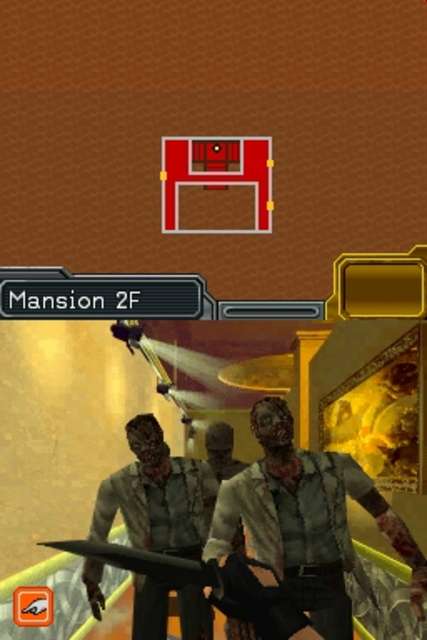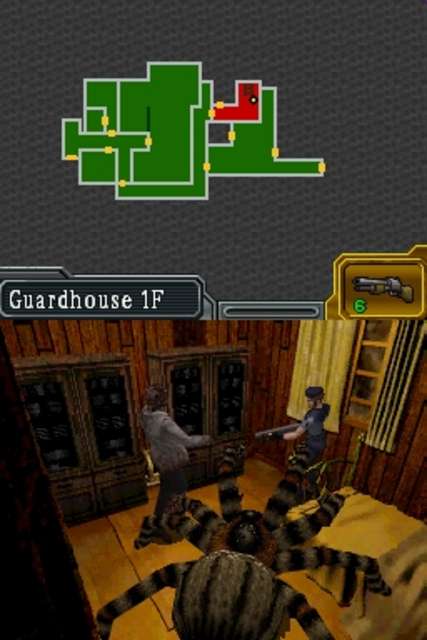Resident Evil: Deadly Silence
It's always the quiet ones…
Resident Evil 4 is an absolutely stonking game. In fact, it's so good that I found myself rummaging through old magazines such as Zzap64! just to find words like 'stonking' to describe just how joyful it is. What makes this even more amazing is that Resident Evil 4 is a very subtle refinement of the Resident Evil series. The same slow, awkward movement, relentless waves of single-minded foes, and puzzles, evolved to include a new claustrophobic third-person camera and a glorious aiming system.
Knowing the core elements of Resident Evil 4 were retained from the original title, I was terribly excited to get my hands on Resident Evil: Deadly Silence, the Nintendo DS remake of the 1996 PlayStation original. "Wicked!" I thought, before rapidly flipping shut a copy of Mean Machines I'd carelessly left open, "With all of the unique features of the DS to exploit, this remake of Resident Evil is going to be totally crucial!".
At that point I made sure to put all of my old magazines back under my bed [with the others? - Ed].

How much of a wally can you be? Despite my excitement, the original Resident Evil is one of gaming's cows that has already been sufficiently milked. The PlayStation original was not only given an update in the form of a director's cut by 1997, but a competent remake on the GameCube in 2002. This latest retread, Resident Evil: Deadly Silence, offers two main modes, 'Rebirth mode', the original Resident Evil with the addition of the new, Nintendo DS specific features, and 'Classic mode', the original Resident Evil as it was in 1996, plus a 'Master of Knifing' mini-game mode, and a local Wi-fi multiplayer mode, akin to Resident Evil: Outbreak.
Even in 'Rebirth mode', however, this is no 'REmake', but a straightforward port - right down to the FMV intro. Cringingly embarrassing, the intro movie features actors as Jill Valentine, Chris Redfield, cult favourite Barry Burton and the rest of the S.T.A.R.S in ill-fitting costumes, running about in a field waving plastic guns, searching for Bravo Team, lost in the mountainous regions near Raccoon City, before (for some reason) concentrating their search in a nearby mansion.
As a 10 year old game on a portable system, flaws purely down to the title's age are easily apparent. The game uses fixed camera angles and pre-rendered backgrounds, and while the low quality rendered backgrounds might have wowed in 1996, a decade on they look indistinct and downright ugly. While new features of later Resident Evil titles are available (a combat knife available from the L trigger, and a quick 180 degree turn), Resident Evil: Deadly Silence keeps the terrifically unfriendly control system that's become synonymous with the series, accentuating the problems of fixed camera angles. The game is a constant struggle with your d-pad, and keeping your character going in any direction as the camera angles change without having them run into walls, objects, or directly into zombies is a unwinnable battle. Indeed, scuffling with zombies is just as hindered. With a mere three angles of fire to chose from, chimeras hanging from the ceiling late in the game can happily rip you to pieces as you rotate on the spot, desperately trying to target them, and dogs and ravens will be happily munching upon your entrails long before you manage to strike them down with a wildly inaccurate knife strike.
Other inherent design aspects destroy the flow of the game, such as the ludicrously strict inventory limit that requires you tediously backtracking to ferry items from inventory boxes in save rooms, and the very concept of the save rooms themselves. Despite shipping on a portable system the game retains the irritating requirement that your character carry sodding ink ribbons to save. Thankfully for players in a hurry, the remarkable sleep mode of the DS works acceptably in such situations, but still...

Positive points are few and far between when examining the classic gameplay on offer in Resident Evil: Deadly Silence. While the plot is at least entertaining, and murdering zombies, even with a horrible controls, is never less than satisfying, the game is an incredibly tiresome slog running from puzzle to puzzle, interspersed with frustrating combat. Even worse, the Rebirth mode is no grand reinvention. Merely the classic mode with a few paltry additions, in general the touch screen only serves to add another level of frustration, with the regular appearance of first person 'knife battles', where you must defend yourself from a horde of enemies that have quite literally appeared from nowhere.
Quite beside the fact that it makes no sense that you'd choose to take on a room full of zombies standing still using only a knife, these segments usually require you to either scrabble around you looking for where you last put the stylus, or to desperately jab your fingers into the screen. A cheap attempt at immersion, it works as little more than a petty annoyance. The reaction time of your character in touch screen segments is frustratingly slow, and in sections such as one in which you are expected to rotate a valve before being poisoned to death, this can be incredibly irritating. I can't really see any good reason to play Rebirth mode, or this game at all, if you've played through Resident Evil in any form before.
It's telling that this title offers far less to a gamer who is new to the series than the four-year old remake on the GameCube. Placed on a handheld, the gravitas of the shock scares is gone, and with unrealistic graphics and a cheese factor turned up to eleven, any feeling of genuine creepiness is lost. While it does keep all the flaws described here, the GameCube remake does at least offer beautiful graphics and some decent shocks.
It's symptomatic of the lack of thought put into this game that the multiplayer mode scandalously requires that each player have their own cart. Deadly Silence is in no sense the radical Resident Evil title on Nintendo DS that we could have hoped for. Instead it's exactly the kind of cynical, soulless cash-in title that we thought Capcom had left behind with the stonking Resident Evil 4.

